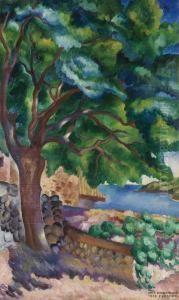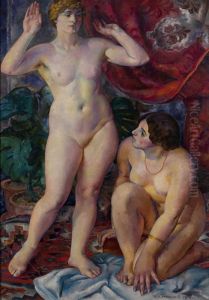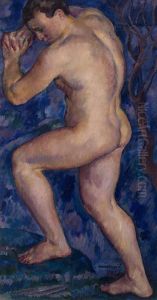Ignaty Nivinsky Paintings
Ignaty Ivanovich Nivinsky was a prominent Russian and Soviet graphic artist, painter, and sculptor, known for his versatility and contribution to the Russian art scene in the early 20th century. Born on December 12, 1881, in Vitebsk, which at the time was part of the Russian Empire and is now in Belarus, Nivinsky was immersed in an environment rich in cultural and artistic heritage, which would later influence his diverse artistic pursuits.
Nivinsky's education in art began at the Imperial Academy of Arts in Saint Petersburg, where he studied from 1900 to 1908. His time at the academy was marked by a rigorous training in classical art, but Nivinsky was also influenced by the burgeoning movements of Art Nouveau and Symbolism. These styles, combined with his classical training, allowed him to develop a unique artistic voice that was both modern and deeply rooted in tradition.
After completing his studies, Nivinsky's career took a path that included both graphic arts and painting, but he is perhaps best known for his work in the graphic arts, particularly in the fields of illustration and book design. His illustrations for Russian fairy tales and classic literature are celebrated for their intricate detail and imaginative composition. Nivinsky was also a skilled sculptor, and his public monuments and reliefs can still be seen in various locations across Russia.
During the tumultuous years of the Russian Revolution and the subsequent establishment of the Soviet Union, Nivinsky's art underwent a transformation. He embraced the ideological shifts of his time and began to incorporate themes of social and political importance into his work. Despite the changing times, he remained committed to the aesthetic quality of his work, striving to balance his artistic integrity with the demands of the new Soviet reality.
Nivinsky's contributions to art were not limited to his own creations. He was also a respected teacher, sharing his knowledge and skills with a new generation of artists at the VKhUTEMAS/VKhUTEIN, the higher art and technical studios/workshops, which were the Soviet Union's state art and technical schools. His teaching and mentorship helped to shape the future of Russian and Soviet art.
Ignaty Ivanovich Nivinsky passed away on November 21, 1933, in Moscow. His legacy is that of a versatile artist who navigated the complexities of his time with creativity and resilience. Through his diverse body of work, Nivinsky remains a significant figure in the history of Russian art, celebrated for his contribution to the graphic arts, painting, and sculpture.


